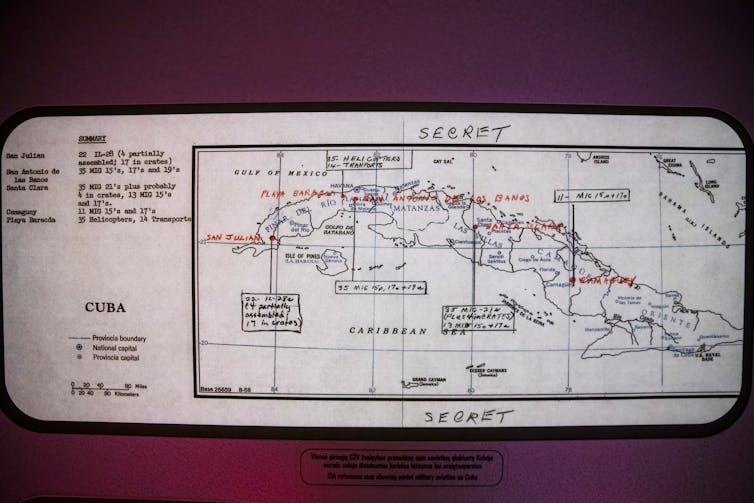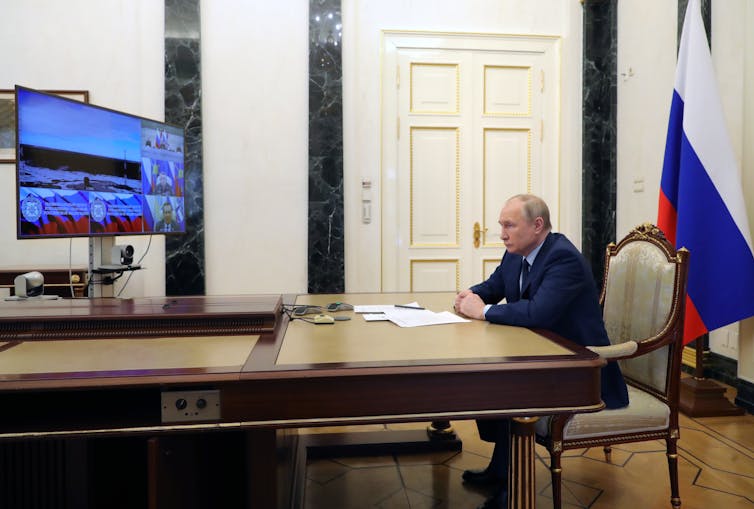[ad_1]
Russia is reported to have held drills this week simulating “nuclear-capable strikes”. In line with an announcement by Russia’s ministry of defence, forces of the Baltic Fleet within the Kaliningrad area, carried out coaching periods to “ship mock missile strikes with the crews of the Iskander operational-tactical missile programs”. The Iskander has a variety of about 300km, so missiles launched from the Kaliningrad area might strike targets in western Ukraine, Poland, the Baltic States and even components of Germany.
The newest drills comply with the disclosing, on April 29, of Russia’s new Sarmat intercontinental ballistic missile (ICBM). The missile can ship their payloads onto targets within the US as much as 18,000km away.
Vladimir Putin stated Sarmat “has no analogues on the earth and won’t have for a very long time to return” and can be “meals for thought for many who, within the warmth of frenzied aggressive rhetoric, attempt to threaten our nation”.
Mutually assured destruction
I’m a researcher at RAF Fylingdales a ballistic missile early warning (BMEWS) station on the North York Moors. I’ve spent the previous three years constructing the Fylingdales Archive, which charts the station’s 60-year historical past of watching the skies for indicators of nuclear assault by ICBMs. BMEWS was inbuilt response to the launch of Sputnik in October 1957. Sputnik was the world’s first synthetic satellite tv for pc, launched from the highest of the world’s first ICBM, the R-7. The satellite tv for pc demonstrated that the Soviet Union had the potential to put a nuclear weapon on a rocket and strike anyplace on Earth with little warning.
Early in 1958, in response to Sputnik, the US Congress signed into existence measures that type the foundations of recent strategic nuclear deterrence. Along with BMEWS, Congress additionally accredited the Atlas, Titan and Minuteman ICBM programmes. These applied sciences shaped the premise of what turned generally known as mutually assured destruction (Mad), which means either side of a possible nuclear battle have sufficient firepower to destroy one another and the remainder of the world.
Errors and miscalculations
Deterrence methods comparable to Mad depend upon a fragile recreation of psychological poker, the danger being that your opponent’s response is likely to be far past what was anticipated.
The hazards of this didn’t take lengthy to materialise. Within the early Sixties, the US had its Jupiter intermediate-range ballistic missiles stationed in Turkey and Italy, which Moscow felt might destroy Russia earlier than it had an opportunity to retaliate. To degree up their deterrent posture, Moscow began to deploy intermediate-range ballistic missiles in Cuba.

Karolis Kavolelis by way of Shutterstock
What ensued went into the historical past books because the Cuban missile disaster – a standoff between the US and Soviet Union, with, between them, 29,700 warheads (the US had 26,400 to the Soviet Union’s 3,300). Every of those weapons on common was tens of occasions extra highly effective than the weapons used in opposition to Hiroshima. Fortunately, sanity prevailed and none had been fired.
Following this disaster, measures had been put in place to ease nuclear tensions between the US and the Soviet Union. These included establishing a hotline between Washington DC and Moscow and limiting the variety of operational ICBMs. However this era of relative detente proved to be short-lived.
The conflict scare and arms management
The early Nineteen Eighties marked a interval of renewed distrust between the nuclear superpowers and a progress within the measurement of nuclear arsenals. By 1986, there have been 70,000 nuclear warheads shared nearly equally between the US and Soviet Russia. How shut the 2 sides got here to confrontation was illustrated by the “conflict scare” of November 1983. Soviet nuclear forces misinterpreted a Nato train known as In a position Archer 83 for the beginning of a nuclear assault. Soviet nuclear forces in Europe had been placed on five-minute standby to launch a preemptive nuclear strike.
As soon as once more, constructive dialogues started between Washington and Moscow had been renewed, culminating within the historic Reykjavik summit between Ronald Reagan and Mikhail Gorbachev in 1986, broadly seen as the start of the top of the chilly conflict.
The summit started many years of disarmament, starting with the signing of the Intermediate-range Nuclear Forces (INF) treaty in 1987. The INF eradicated intermediate-range ballistic missiles from US and Soviet arsenals. It additionally paved the way in which for the Strategic Arms Discount Treaties (Begin), which successfully put a cap on nuclear proliferation, at the least between the world’s two large nuclear superpowers.

EPA-EFE/Mikhail Klimentyev/Kremlin pool/Sputnik
However the finish of the Soviet Union introduced an unsure time for arms management processes as central command buildings fragmented. The breakup of the Soviet Union additionally dangerously elevated the variety of nations with nuclear weapons. In 1991 Lithuania, Belarus and Ukraine had been left in possession of over 2,000 former Soviet warheads. Following the signing of the Budapest Memorandum in January 1994 these weapons had been returned to Russia and have become topic to disarmament course of set out by Begin.
Learn extra:
Ukraine conflict: what’s the Budapest Memorandum and why has Russia’s invasion torn it up?
These arms discount regimes had been so profitable that by 2012, 80% of the US and Russian nuclear peak stockpiles had been eradicated.
Eve of destruction?
However world leaders seem to have developed a renewed urge for food for nuclear weapons. In 2019, nations comparable to China (US$10 billion – or £8 billion) and India (US$2.3 billion) have made vital invesments of their strategic nuclear forces. In the meantime, the UK introduced in 2021 that it’s going to improve its stockpile from 180 warheads to 240.
Donald Trump’s withdrawal of the US from the historic INF Treaty in September 2019, blaming Russia for deploying cruise missiles that breached the INF settlement, was additionally a bitter blow for disarmament campaigners.
Putin has used the specter of nuclear conflict a number of occasions lately. His motion of the Iskander missiles to Kaliningrad in 2018 was a direct risk to Baltic states comparable to Poland and Lithuania, each members of Nato. And now Russia is demonstrating that, if it needs, they’re there for use.
Within the absence of arms management, nuclear weapons preserve their harmful symbolic attract for leaders comparable to Putin. However the stark fact is that nuclear weapons have all the time put the world in catastrophic hazard.
[ad_2]
Source link















